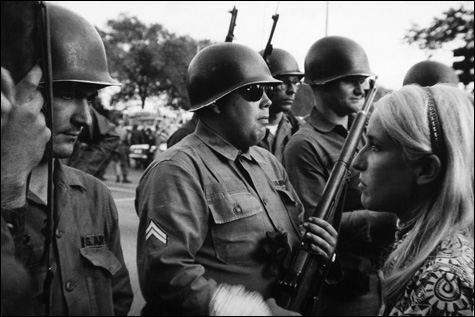
THE FACE OF A NATION? Mayor Daley’s finest assemble. |
| “The Whole World Was Watching: Images From The 1968 Chicago Riots” | Panopticon Gallery, Hotel Commonwealth, 502 Comm Ave, Boston | Through October 6 |
It was August 28, 1968, and Ron Pownall could feel the storm brewing as he arrived at a Vietnam War protest during the Democratic Convention in Chicago: “The police were chomping at the bit to bust some butts. It was in the air, palpable tension all day.” That afternoon and night it exploded in what a national commission later declared a “police riot.”Twenty-five of his photos of that day — 40 years ago today — are on view at Panopticon Gallery in “The Whole World Was Watching.” (The title alludes to the demonstrators’ chanting of “The whole world is watching” as the violence was filmed by television news cameras and broadcast around the world.) The anniversary coincides with this week’s Democratic National Convention in Denver, as we look again to replace a Texas president who led the nation into an ill-considered war.
Pownall, who lives in Weston, is best known as a rock-and-roll photographer. (Three of his music photos — one a shot of Jimi Hendrix — are featured here.) His finest stuff freezes rockers in mid motion, in hot, sexy, ecstatic instants. He began photographing big concerts in ’68, when he was 21. That same year, he landed a summer job photographing for the Chicago Tribune.
On Wednesday August 28, the Tribune sent Pownall out with a 35mm Nikon F to photograph a rally that was trying to draft Ted Kennedy to run for president. Kennedy announced he wasn’t interested, whereupon Pownall called the newspaper from a pay phone and was sent downtown to Grant Park to check out the anti-war rally.
“As long as I am mayor,” Chicago’s Richard J. Daley had vowed more than once in the run-up to the convention, “there will be law and order in Chicago.” Daley marshaled 25,000 armed police, National Guard, and security men against an estimated 5000 protesters throughout the city.
Pownall arrived at the park around two in the afternoon. He photographed dozens of Chicago police assembling. He photographed National Guard troops with rifles arriving by truck, panning his camera to follow the movement of the vehicle, subtly blurring a crowd of protesters in front and trees behind while keeping the ominous truck in focus, thereby drawing our attention to it.
He photographed anti-war organizer and Students for a Democratic Society leader Carl Oglesby speaking and protest singer Phil Ochs playing guitar on a bandshell stage. He photographed police handing out leaflets to people seated on benches in the audience asking them to protest peacefully. He photographed a protester pulling down an American flag from a pole and getting stopped by police as he tried to raise a North Vietnamese flag. Just then, Pownall’s first five or so rolls of black-and-white film ran out, so he missed getting shots of the cops as they “beat the shit out of that kid. And that was right in front of the stage.”
Pownall bought more film from people in the crowd and roving Tribune reporters supplied him with fresh rolls so he could photograph lines of police brandishing billy clubs and National Guard troops bristling with rifles. They squared off with young, unarmed white and black protesters. In one shot, a woman with long blond hair stands face to face with a row of soldiers who gaze dispassionately over her head.
The anti-war crowd wanted to march to the convention hall, but the city refused the necessary permits. Many wanted to go anyway, but police and troops hemmed them in, and as Pownall remembers it, poet Allen Ginsberg and anti-war leader David Dellinger tried to talk everybody out of a confrontation. (Pownall shows the men speaking into microphones; Dellinger is surrounded by cops.) A line of police marched into the crowd, clubbing those who didn’t flee; “It was like having a tank roll down,” Pownall tells me. A pair of shots show a line of helmeted cops with billy clubs bearing down on a long-haired protester who seems strangely unaware of them. A cop maces the guy. Another shot shows persons tending to SDS leader Rennie Davis as he lies on the grass, his shirt and tie bloodied and the top of his head bandaged. A pair of photos show a protester hurling a tear-gas canister back at police and officers ducking.
“The police walked through the crowd and it was like stirring up a hornets’ nest,” Pownall says. Protesters overturned benches in front of the bandshell and attacked an empty police car. Pownall’s shots are gritty seat-of-the-pants photojournalism, a good glimpse of a single heated afternoon, but he’s often in not quite the right place at not quite the right time. He’s a better photographer than this. But the images maintain their spark because the events turned out to be historic.